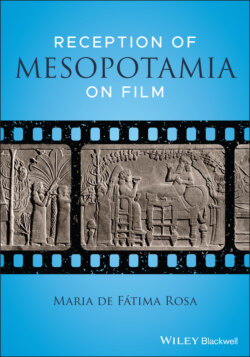Reception of Mesopotamia on Film

Реклама. ООО «ЛитРес», ИНН: 7719571260.
Оглавление
Maria de Fatima Rosa. Reception of Mesopotamia on Film
Reception of Mesopotamia on Film
Contents
List of Illustrations
Guide
Pages
List of Abbreviations
Acknowledgments
Introduction: Reception of Mesopotamia and the Cinema Lens. 0.1 Reception Studies and Cinema
0.2 Why Cinema? What Cinema?
0.3 Orientalism and the Legacy of Ancient Mesopotamia
Notes
1 The Old Testament Paradigm and the Romanticism of the Classics. 1.1 The Genesis of Confusion. 1.1.1 From Babylon to Babel
1.1.2 In the Beginning, Nimrod
1.1.3 Daniel and the Ruin of the Neo-Babylonian Empire
1.2 Greek Ethnocentricity and the Emergence of Legendary Figures. 1.2.1 A Discourse About the Other
1.2.2 The Subversion of Roles: The Dilution of the Male/Female Binomial
Notes
2 Mesopotamia in Literature and on Stage. 2.1 The Resurrection of Classical Legendary Figures
2.2 Tragic Mesopotamian Heroes and Their Dramatization. 2.2.1 Semiramis from Manfredi to Rossini
2.2.2 Sardanapalus, Myrrah and Their Fateful Destiny
2.2.3 The Various Nabuccos
Notes
3 The Appropriation and Visual Reproduction of Assyria and Babylon. 3.1 Mesopotamia Pre-discovered: Testimonies from an Unknown World
3.2 The Archaeological Exploration
3.3 Mesopotamia Post-discovered: The Introduction of Assyrianizing Elements
Notes
4 Genres and Cinematographic Contexts. 4.1 Why Antiquity?
4.2 Early French Cinema and Its Motivations
4.3 American Cinema, the Epic Genre, and the Judeo-Christian Legacy
4.4 Italian Cinema and the Greco-Roman Heritage. 4.4.1 The First Golden Age
4.4.2 Peplum and the Genesis of the West
Notes
5 Mesopotamia as the Seed of Evil. 5.1 Resurrecting Ancient Near Eastern Demons
5.2 Present Speeches From an Ancient Demoniacal Past. 5.2.1 Religious Narratives: The Apocalypse and the Whore of Babylon
5.2.2 Political Narratives: Communism, Capitalism, Nazism, and Terrorism
Notes
6 Imagining the Land Between the Rivers: Urbanism and Culture. 6.1 The City as a Privileged Setting. 6.1.1 The Hyperbolizing of Urban Architecture
6.1.2 The Polarization of the City: Palace and Temple
6.2 The Ziggurat Tower: Babel Intertwining Past and Present
6.3 Exoticism and Modernism: Colliding Worlds in Mesopotamia. 6.3.1 Hybridism and Advance Machinery in the Era of Industrial Revival
6.3.2 Universalizing Mesopotamia in Post-Fascist Italy
Notes
7 Exploring Mesopotamia’s Society and Politics. 7.1 A Portrait of the King and Queen and Their Population. 7.1.1 Eastern Stereotypes and Socio-political Contexts
7.1.2 The Mesopotamian Fascist vs. The Mesopotamian Apostle of Tolerance
7.2 Religion and Politics. 7.2.1 Gods at War: Idolatry, Holocaust and the Judeo-Christian Faith
7.2.2 It’s Every Man for Himself
Notes
8 The Ancient Near Eastern Woman Under the Lens. 8.1 Judith against Assyria. 8.1.1 Female Emancipation vs. Biblical Conservatism
8.1.2 The Debate Regarding the “New Woman”
8.2 The Two Semiramis
8.3 Mesopotamian Bacchanals and Odd Rituals
Notes
9 Farewell Babylon, Farewell Nineveh
Notes
Bibliography. On the Theoretical Framework
On Mesopotamia and the Ancient Near East
On Twentieth Century Historical Context
On Literary and Artistic Productions Before the Cinema Era
On cinema
Index
WILEY END USER LICENSE AGREEMENT
Отрывок из книги
Maria de Fátima Rosa
NOVA University LisbonLisbon, Portugal
.....
1) – The short movies produced from 1905 up until the middle of the 1910s, which consisted of silent films that had an estimated time of 6 to 15 minutes (predominantly Italian and French productions);
2) – The silent movies produced in the second half of the 1910s and during the 1920s, which were the first feature films ever produced on Mesopotamia and had a variable time duration (predominantly American productions);58
.....